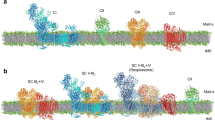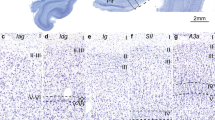Summary
Stacks of regularly spaced, flat, smooth-surfaced endoplasmic reticulum cisternae, frequently observed in both the cell body and dendrites of cerebellar Purkinje neurons, were previously shown by immunocytochemistry to be highly enriched in receptors for the second messenger, inositol 1,4,5-trisphosphate. Morphometric analyses have been carried out on randomly selected thin section images of rat Purkinje neurons to reveal the tridimensional organization of these structures. Individual stacked cisternae (on the average ≈ 3.5 per stack) were shown to be separated from each other by a 23.5 nm space occupied by perpendicular bridges, ≈ 20 nm in diameter, most probably composed by two apposed receptor homotetramer molecules, inserted into the parallel membranes in their hydrophobic domains. In the stacked membranes the density of the bridges was ≈ 500 μm−2, corresponding to ≈ 15% of the surface area. The lateral distribution of bridges was not random, but revealed regular distances that might correspond to unoccupied receptor slots. In each stack, the external cisternae were often in direct lumenal continuity with conventional elements of the endoplasmic reticulum, whereas the internal cisternae were not. Since continuities between stacked cisternae were never observed, the results indicate that the internal cisternae are at least transitorily discrete, i.e. they are not in permanent lumenal continuity with the rest of the endoplasmic reticulum. To our knowledge this is the first demonstration of a physical subcompartmentalization of the latter endomembrane system in a non-mitotic cell. A model for the biogenesis of cisternal stacks, based on the head-to-head binding and lateral interaction of the inositol 1,4,5-trisphosphate receptor molecules in the plane of the interacting membranes, is proposed and critically discussed.
Similar content being viewed by others
References
Ambartsumyan, R. V., Mecke, J. &Stoyan, D. (1989)Introduction to Stochastic Geometry. Moscow/Berlin: Nauka/WTB.
Anderson, K., Lai, F. A., Lin, Q. Y., Rousseau, E., Erickson, H. P. &Meissner, G. (1989) Structural and functional characterization of the purified cardiac ryanodine receptor-Ca2+ release channel complex.Journal of Biological Chemistry 264, 1329–35.
Berridge, M. J. &Irvine, R. (1984) Inositol trisphosphate, a novel second messenger in cellular signal transduction.Nature 312, 315–21.
Dabora, S. L. &Sheetz, M. P. (1988) The microtubuledependent formation of a tubulovesicular network with characteristics of the ER from cultured cell extracts.Cell 54, 27–35.
De Hoff, R. T. (1962) The determination of the size distribution of ellipsoidal particles from measurement made in random plane sections.Transactions of the Metallurgical Society of AIME 224, 474–7.
Fleischer, S. &Inui, M. (1989) Biochemistry and biophysics of excitation-contraction coupling.Annual Review ofBiophysics and Biophysical Chemistry 18, 333–64.
Franzini-Armstrong, C., Kenney, L. J. &Varriano-Marston, E. (1987) The structure of calsequestrin in triads of vertebrate skeletal muscle: a deep-etch study.Journal of Cell Biology 105, 49–56.
Gray, E. G. (1959) Electron microscopy of synaptic contacts on dendrite spines of the cerebral cortex.Nature 183, 1592–3.
Hansson, H.-A. (1981) Lamellar bodies in Purkinje nerve cells experimentally induced by electric field.Brain Research 216, 187–91.
Herndon, R. M. (1964) Lamellar bodies, an unusual arrangement of the granular endoplasmic reticulum.Journal of Cell Biology 20, 338–42.
Heuser, J. E. (1976) Morphology of synaptic vesicle discharge and reformation at the frog neuromuscular junction. InMotor Innervation of Muscle (edited byThesleff, S.) 51–115. London: Academic Press.
Inui, M., Saito, A. &Fleischer, S. (1987) Isolation of the ryanodine receptor from cardiac sarcoplasmic reticulum and identity with the feet structures.Journal of Biological Chemistry 262, 15637–42.
Karlsson, U. &Schultz, R. L. (1966) Fixation of the central nervous system for electron microscopy by aldehyde perfusion. III. Structural changes after exsanguination and delayed perfusion.Journal of Ultrastructure Research 14, 47–63.
Le Beux, J. (1972) Subsurface cisterns and lamellar bodies: particular forms of the endoplasmic reticulum in the neurons.Zeitschrift für Zellforschung 133, 327–52.
Lee, C. &Chen, L. B. (1988) Dynamic behavior of endoplasmic reticulum in living cells.Cell 54, 37–46.
Maeda, N., Niinobe, M., Inoue, Y. &Mikoshiba, K. (1989) Developmental expression and intracellular location of P400 protein characteristic of Purkinje cells in the mouse cerebellum.Developmental Biology 133, 67–76.
Meldolesi, J. (1992) Multivarious IP3 receptors.Current Biology 2, 393–4.
Mignery, G. A., Sudhof, T. C., Takei, K. &De Camilli, P. (1989) Putative inositol 1,4,5-trisphosphate receptor similar to ryanodine receptor.Nature 342, 192–5.
Otsu, H., Yamamoto, A., Maeda, N., Mikoshiba, K. &Tashiro, Y. (1990) Immunogold localization of inositol 1,4,5-trisphosphate (Ins-P3) receptor in mouse cerebellar Purkinje cells using three monoclonal antibodies.Cell Structure and Function 15, 163–73.
Rios, E., Ma, J. &Gonzales, A. (1991) The mechanical hypothesis of excitation-contraction (EC) coupling in skeletal muscle.Journal Muscle Research and Cell Motility 12, 127–35.
Ross, C. A., Meldolesi, J., Milner, T. A., Satoh, T., Supattapone, S. &Snyder, S. (1989) Inositol 1,4,5-trisphosphate receptor localized to endoplasmic reticulum in cerebellar Purkinje neurons.Nature 339, 468–70.
Rusakov, D. A. (1992) Estimation of the size distribution of closed cell elements from analysis of their plane random sections.Biometrics, in press.
Rusakov, D. A., Berezovskaya, O. L. &Skibo, G. G. (1993) Cytoskeleton-mediated, age-dependent lateral topography of lectin-gold labelled molecules on the plasma membrane of cultured neurons: a statistical view.Neuroscience 52, 369–79.
Santalo, L. A. (1976) Integral geometry and geometric probability. InEncyclopedia of Mathematics and its Applications, vol. 1, pp. 1–311, Reading, MA: Addison-Wesley.
Satoh, T., Ross, C. A., Villa, A., Supattapone, S., Pozzan, T., Snyder, S. &Meldolesi, J. (1990) The inositol 1,4,5-trisphosphate receptor in cerebellar Purkinje cells: quantitative immunogold labeling reveals concentration in an ER subcompartment.Journal of Cell Biology 111, 615–24.
Takei, K., Stukenbrok, H., Metcalf, A., Mignery, G., Südhof, T., Volpe, P. &De Camilli, P. (1992) Ca2+ stores in Purkinje neurons: endoplasmic reticulum subcompartments demonstrated by the heterogeneous distribution of the Ins-P3 receptor, Ca2+-ATPase and calsequestrin.Journal of Neuroscience 12, 489–505.
Terasaki, M. &Jaffe, L. A. (1991) Organization of the sea urchin egg endoplasmic reticulum and its reorganization at fertilization.Journal of Cell Biology 114, 929–40.
Van Nimwegen, D. &Sheldon, H. (1966) Early postmortem changes in cerebellar neurons of the rat.Journal of Ultrastructure Research 14, 36–46.
Villa, A., Pondini, P., Clegg, D. O., Pozzan, T. &Meldolesi, J. (1991) Ca2+ stores in chicken Purkinje neurons: differential distribution of the low affinity-high capacity Ca2+ binding protein, calsequestrin, of Ca2+ ATPase and of ER lumenal protein, BiP.Journal of Cell Biology 113, 779–91.
Villa, A., Sharp, A. H., Racchetti, G., Podini, P., Bole, D. G., Dunn, W. A., Pozzan, T., Snyder, S. H. &Meldolesi, J. (1992) The endoplasmic reticulum of Purkinje neuron body and dendrites: molecular identity and specializations for Ca2+ transport.Neuroscience 49, 467–77.
Volpe, P., Alderson-Lang, B. H., Madeddu, L., Damiani, E., Collins, J. H. &Margreth, A. (1990) Calsequestrin, a component of the inositol 1,4,5-trispho-sphate-sensitive Ca2+ store of chicken cerebellum.Neuron 5, 713–21.
Yamamoto, A., Otsu, H., Yoshimuri, T., Maeda, N., Mikoshiba, K. &Tashiro, Y. (1992) Stacks of flattened smooth endoplasmic reticulum enriched in inositol 1,4,5-trisphosphate (Ins-P3) receptor in mouse cerebellar Purkinje cells.Journal of Cell Science, in press.
Yuan, S., Arnold, W. &Jorgensen, A. O. (1991) Biogenesis of transverse tubules and triads: immunolocalization of the 1,4-dihydropyridine receptor, TS28, and the ryanodine receptor in rabbit skeletal muscle developingin situ.Journal of Cell Biology 112, 289–301.
Author information
Authors and Affiliations
Rights and permissions
About this article
Cite this article
Rusakov, D.A., Podini, P., Villa, A. et al. Tridimensional organization of Purkinje neuron cisternal stacks, a specialized endoplasmic reticulum subcompartment rich in inositol 1,4,5-trisphosphate receptors. J Neurocytol 22, 273–282 (1993). https://doi.org/10.1007/BF01187126
Received:
Revised:
Accepted:
Issue Date:
DOI: https://doi.org/10.1007/BF01187126




